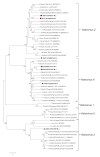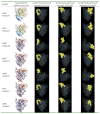Whole Genome Sequence Analysis of Porcine Astroviruses Reveals Novel Genetically Diverse Strains Circulating in East African Smallholder Pig Farms
- PMID: 33167568
- PMCID: PMC7694451
- DOI: 10.3390/v12111262
Whole Genome Sequence Analysis of Porcine Astroviruses Reveals Novel Genetically Diverse Strains Circulating in East African Smallholder Pig Farms
Abstract
Astroviruses (AstVs) are widely distributed and are associated with gastroenteritis in human and animals. The knowledge of the genetic diversity and epidemiology of AstVs in Africa is limited. This study aimed to characterize astroviruses in asymptomatic smallholder piglets in Kenya and Uganda. Twenty-four samples were randomly selected from a total of 446 piglets aged below 6 months that were initially collected for rotavirus study and sequenced for whole genome analysis. Thirteen (13/24) samples had contigs with high identity to genus Mamastrovirus. Analysis of seven strains with complete (or near complete) AstV genome revealed variable nucleotide and amino acid sequence identities with known porcine astrovirus (PoAstV) strains. The U083 and K321 strains had nucleotide sequence identities ranging from 66.4 to 75.4% with the known PoAstV2 strains; U460 strain had nucleotide sequence identities of 57.0 to 65.1% regarding the known PoAstV3; and K062, K366, K451, and K456 strains had nucleotide sequence identities of 63.5 to 80% with the known PoAstV4 strains. The low sequence identities (<90%) indicate that novel genotypes of PoAstVs are circulating in the study area. Recombination analysis using whole genomes revealed evidence of multiple recombination events in PoAstV4, suggesting that recombination might have contributed to the observed genetic diversity. Linear antigen epitope prediction and a comparative analysis of capsid protein of our field strains identified potential candidate epitopes that could help in the design of immuno-diagnostic tools and a subunit vaccine. These findings provide new insights into the molecular epidemiology of porcine astroviruses in East Africa.
Keywords: East Africa; glycosylation; linear antigenic epitopes; porcine astroviruses; recombination; whole genome sequences.
Conflict of interest statement
The authors declare no conflict of interest.
Figures




Similar articles
-
Whole genome analysis of porcine astroviruses detected in Japanese pigs reveals genetic diversity and possible intra-genotypic recombination.Infect Genet Evol. 2017 Jun;50:38-48. doi: 10.1016/j.meegid.2017.02.008. Epub 2017 Feb 9. Infect Genet Evol. 2017. PMID: 28189887
-
High genetic diversity and recombination events of porcine astrovirus strains identified from ill and asymptomatic pigs in 2017, Hunan Province, China.Virus Genes. 2019 Oct;55(5):673-681. doi: 10.1007/s11262-019-01692-w. Epub 2019 Aug 1. Virus Genes. 2019. PMID: 31372920
-
Identification and Characterization of a Novel Recombinant Porcine Astrovirus from Pigs in Anhui, China.Pol J Microbiol. 2020 Dec;69(4):471-478. doi: 10.33073/pjm-2020-051. Epub 2020 Dec 27. Pol J Microbiol. 2020. PMID: 33574875 Free PMC article.
-
Scoping review on the epidemiology, diagnostics and clinical significance of porcine astroviruses.Transbound Emerg Dis. 2022 May;69(3):974-985. doi: 10.1111/tbed.14123. Epub 2021 May 12. Transbound Emerg Dis. 2022. PMID: 33900029
-
Astrovirus evolution and emergence.Infect Genet Evol. 2019 Apr;69:30-37. doi: 10.1016/j.meegid.2019.01.009. Epub 2019 Jan 11. Infect Genet Evol. 2019. PMID: 30639546 Free PMC article. Review.
Cited by
-
Epidemiological investigation and genetic characterization of porcine astrovirus genotypes 2 and 5 in Yunnan province, China.Arch Virol. 2022 Feb;167(2):355-366. doi: 10.1007/s00705-021-05311-8. Epub 2021 Nov 28. Arch Virol. 2022. PMID: 34839421 Free PMC article.
-
Prevalence, Genetics, and Evolution of Porcine Astrovirus 3 in China.Transbound Emerg Dis. 2025 Jul 24;2025:3170440. doi: 10.1155/tbed/3170440. eCollection 2025. Transbound Emerg Dis. 2025. PMID: 40746759 Free PMC article.
-
Comparative Analysis of Novel Strains of Porcine Astrovirus Type 3 in the USA.Viruses. 2021 Sep 17;13(9):1859. doi: 10.3390/v13091859. Viruses. 2021. PMID: 34578440 Free PMC article.
-
Identification of a Novel Astrovirus Associated with Bovine Respiratory Disease.Transbound Emerg Dis. 2023 Apr 4;2023:8512021. doi: 10.1155/2023/8512021. eCollection 2023. Transbound Emerg Dis. 2023. PMID: 40303779 Free PMC article.
-
Mapping Potential Vaccine Candidates Predicted by VaxiJen for Different Viral Pathogens between 2017-2021-A Scoping Review.Vaccines (Basel). 2022 Oct 24;10(11):1785. doi: 10.3390/vaccines10111785. Vaccines (Basel). 2022. PMID: 36366294 Free PMC article.
References
-
- Bosch A., Guix S., Krishna N.K., Mendez E., Monroe S.S., Pantin-Jackwood M., Schultz-Cherry S. Family Astroviridae. In: King A.M.Q., Lefkowitz E., Adams M.J., Carstens E.B., editors. Virus Taxonomy: Classification and Nomenclature of Viruses (Ninth Report of the International Committee on the Taxonomy of Viruses) Elsevier Academic Press; New York, NY, USA: 2011. pp. 953–959.
-
- Glass R.I., Noel J., Mitchell D., Herrmann J.E., Blacklow N.R., Pickering L.K., Dennehy P., Ruiz-Palacios G., de Guerrero M.L., Monroe S.S. The changing epidemiology of astrovirus-associated gastroenteritis: A review. Arch. Virol. Suppl. 1996;12:287–300. - PubMed
Publication types
MeSH terms
Supplementary concepts
LinkOut - more resources
Full Text Sources

